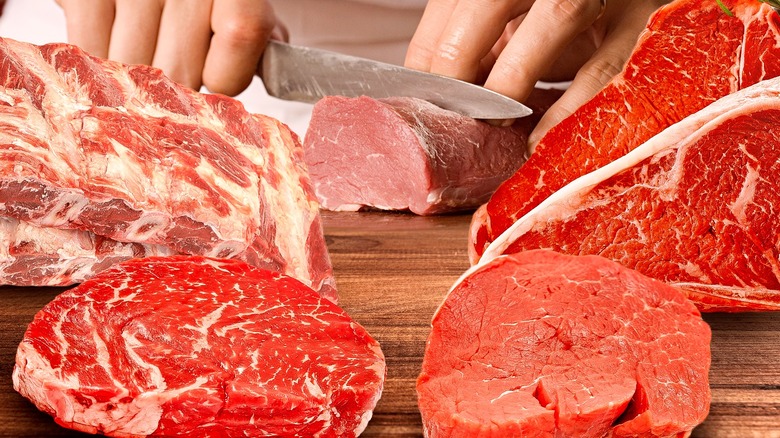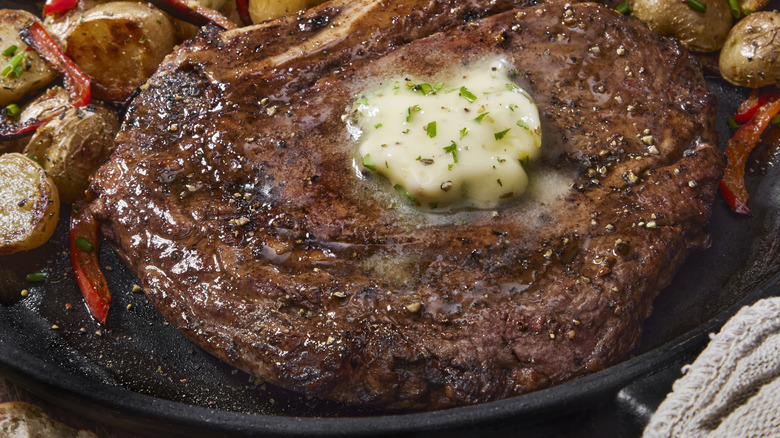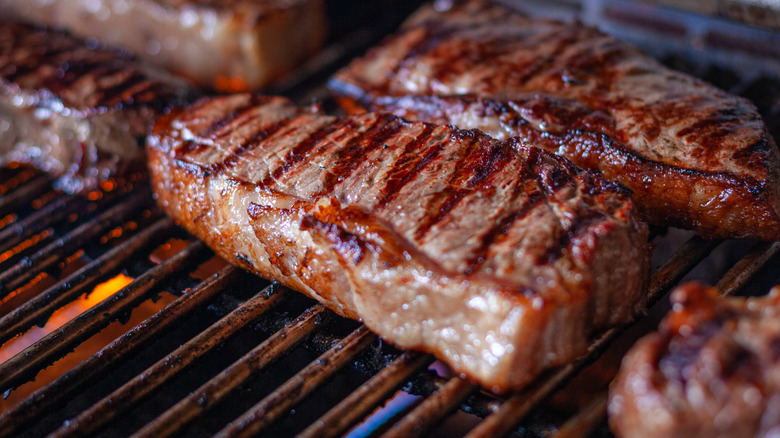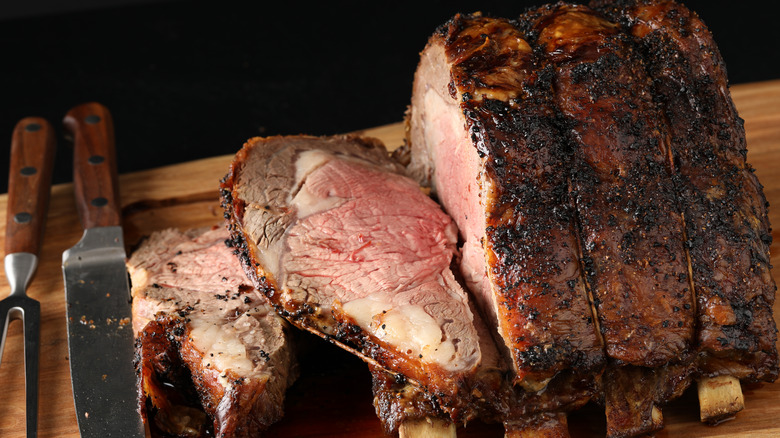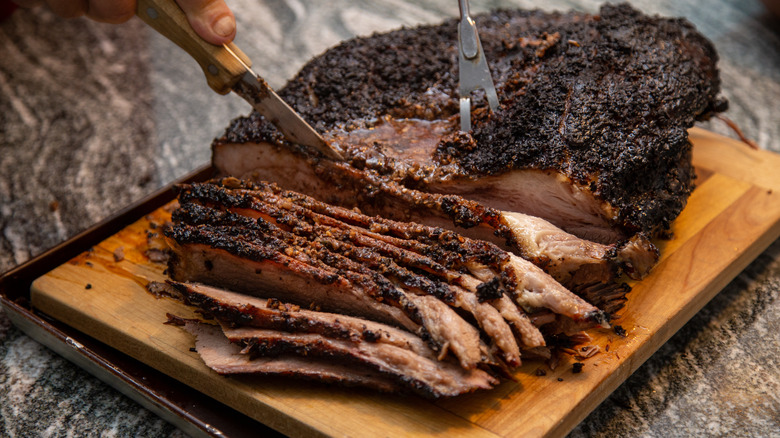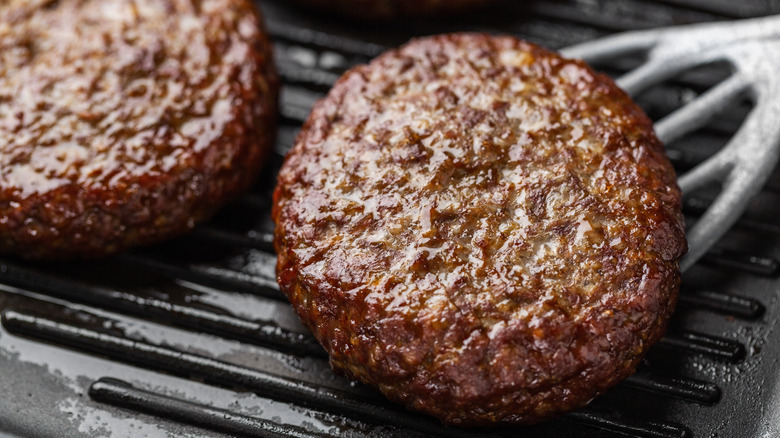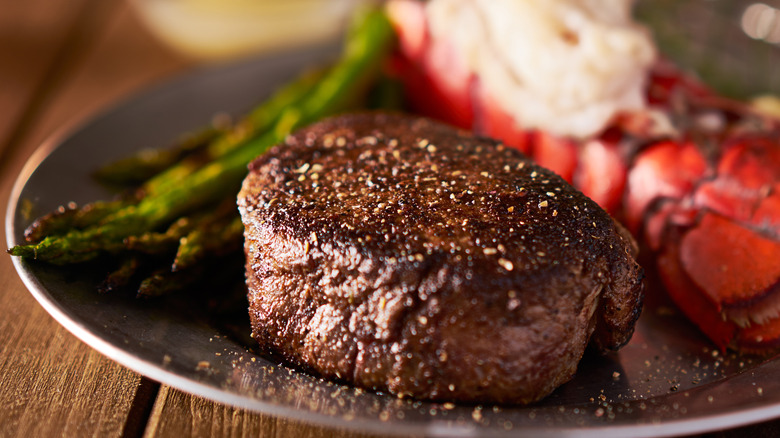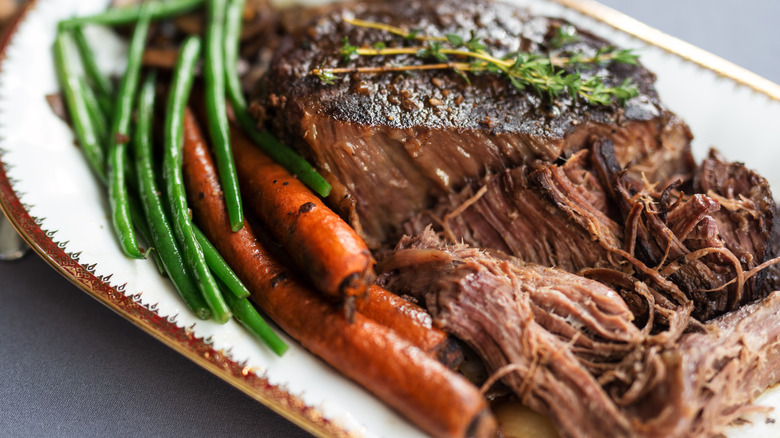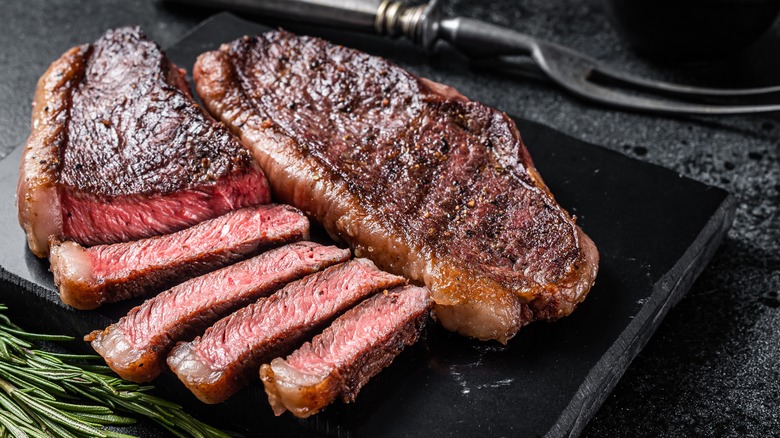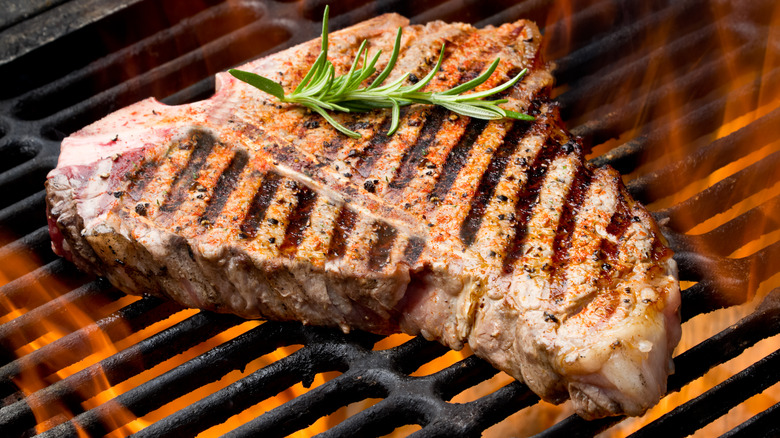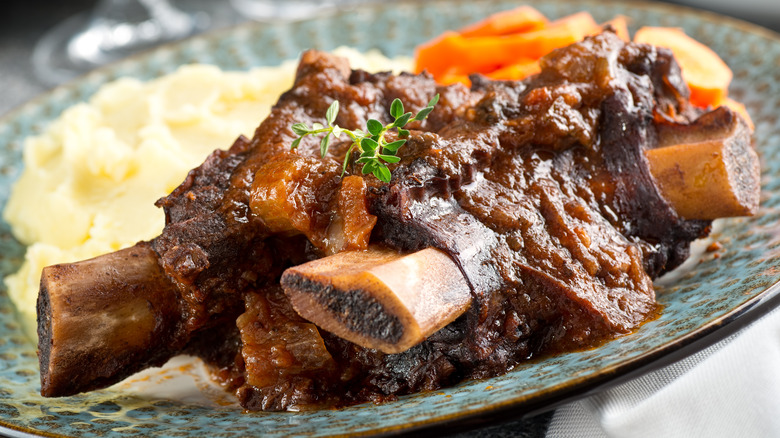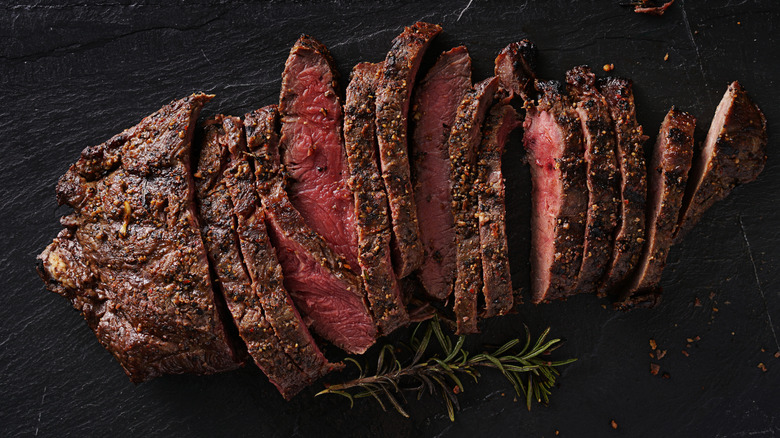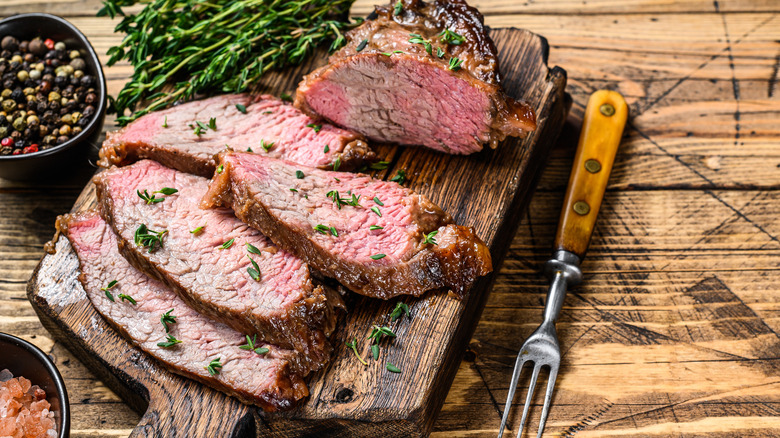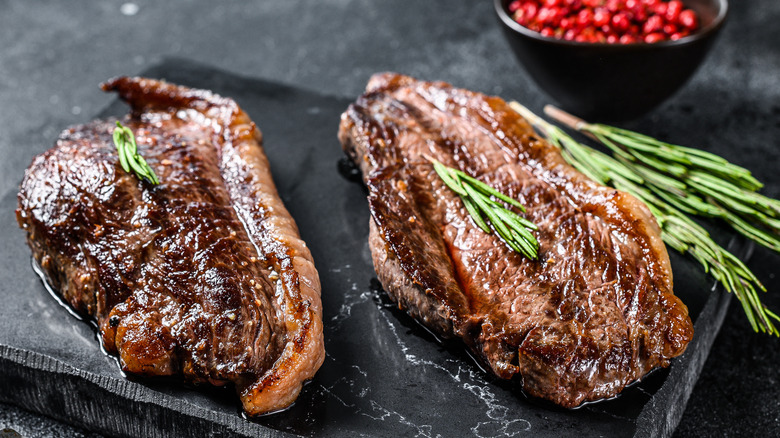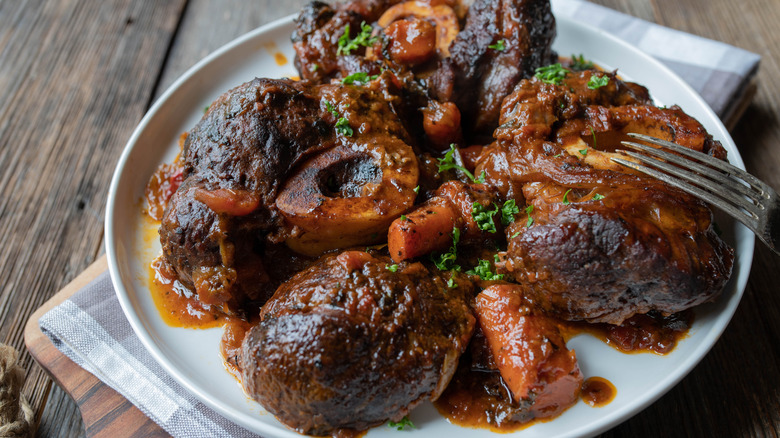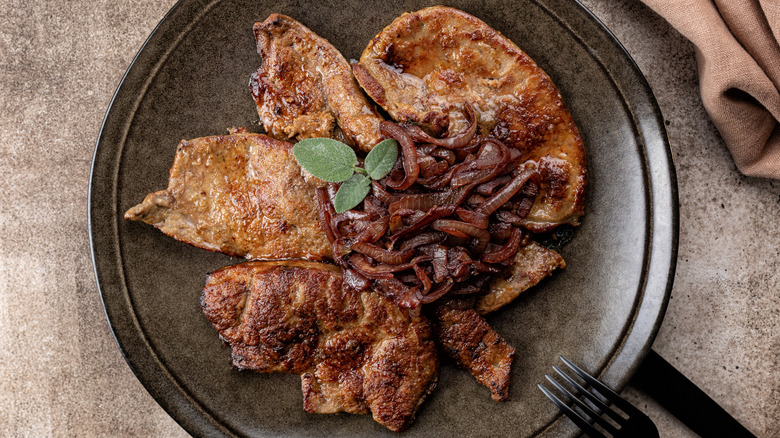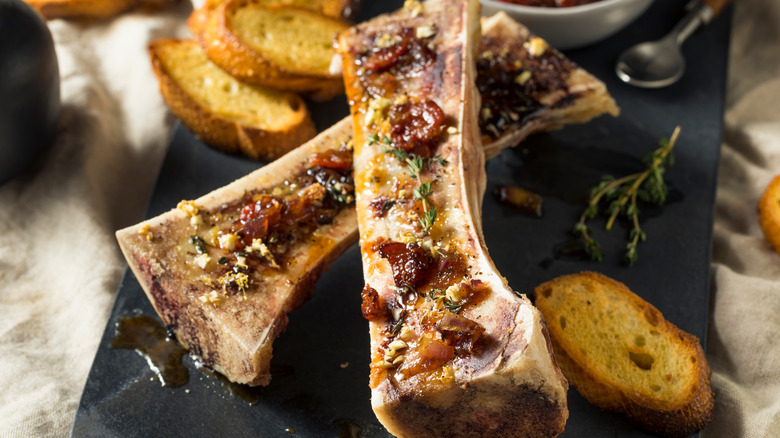The Best Ways To Cook 16 Popular Cuts Of Beef
With dozens of beef cuts to choose from, it's no wonder we tend to stick to the same 'ole burger or pot roast in our rotating, weekly meal plan. Going beyond the usual grilled hamburger or slow-cooked roast may require venturing past the most popular beef section at your local grocery store.
If you've ever taken a peek at the NY strips or ribeyes nestled in among the sirloin or brisket and, given the higher prices, wondered how not to ruin a good piece of steak, we're here to provide you with the information you need to shop the meat department like a pro and put dinner on the table with confidence.
We drew on decades of culminated experience, polled on X, formerly known as Twitter, and took into account cooking method, temperature, and final internal doneness, to determine the best ways to cook more than a dozen popular cuts of beef.
Ribeye steak — Pan sear
Great debate is had over the best way to cook a ribeye steak. Ribeye enthusiasts argue for either the grill or cast iron pan as the premier way to achieve a mouth-watering, juicy ribeye. To shed some light on this debate, we took to X to poll a purely carnivorous audience to find the favored way of partaking in a ribeye. After speaking with a couple dozen serious meat lovers — those who cook steak day in and day-out, searing the ribeye in the cast iron pan barely won over grilling (but was almost always topped with creamy butter either way). So at least in the heart of diehards, the debate for the best cooking method still stands.
Ribeye steaks are cut from the rib primal, which is located behind the shoulder under the backbone. Because the area is used mostly for support, cuts from the rib are full of marbling, resulting in some of the best cuts on the cow. And the cast iron pan is arguably still one of the best ways to cook almost any food. Cast iron delivers a sear typically unbeaten by other cooking methods, giving you the desired crust and umami of a stellar steak. To help you enjoy this top cut, we suggest following our tips for getting the perfect sear on your ribeye steak.
NY strip steak — Grill
Whether you're team ribeye or team NY strip, you're probably still debating about the best way to cook either one: grill or cast iron pan? Though we vote for a grilled NY strip any day of the week, we polled the carnivore community on X to determine how everyone likes their NY strip cooked: grilled, pan-seared, or sous vide. More than half of those polled prefer NY strips grilled, although one respondent suggested returning the strip steak to the store and purchasing a ribeye instead.
Located on the loin primal, situated between the ribs and sirloin under the backbone, the NY strip is a tender, flavorful cut that's well-marbled, making it a top choice for the grill. Like other drool-worthy steaks, you're looking for a NY strip that has a crispy, caramelized crust on the outside and features a tender, easy chew on the inside, ending in a bite that's bursting with rich, savory beefiness. Ina Garten's go-to method for grilling NY strip steaks includes timing your sear perfectly so you get a nice outer, flame-grilled taste and texture but still achieve the medium-rare, juicy inside that has you licking your lips.
Prime rib roast — Oven roast
Prime rib roast slow-cooked in the oven is an eye-catching hunk of meat for your dinner table that just might elicit "oohs" and "ahhs" before digging in. Prime rib is as the name suggests — from the primal rib, just like ribeye steak. But unlike the steaks, it's a roast that requires a lengthy cooking time. But since the roast is more like multiple ribeyes all packed together, you can get a prime rib roast, bone-in or not, and slice it yourself to create individual steaks.
Roasting a prime rib in the oven is a worthwhile culinary adventure for anyone. It's chock full of marbling, which leads to scrumptious flavor and incredibly tender meat. Whether you choose high-heat and then low-n-slow or switch it up and reverse the sear, a succulent prime rib roast requires two things: 10 to 15 minutes (depending on size) at 500 F to sear the outside and low and slow for the win either in a warm oven or when the roast is resting.
Brisket — Smoke
We know what you're thinking, but smoking brisket is not as complicated as it sounds. And it's brisket. Learn how to make smoked brisket and you won't walk past that big slab of beef again without wanting the slow-cooked, smoky umami most known of this rustic cut of beef. Brisket is available in its entirety, in which case you're looking at about 10 to 16 pounds, or as the point or flat, both of which are usually sold as 5 to 8 pounds.
Brisket is certainly delicious ground up for hearty burgers and this cut does well when braised, but smoking the brisket gives you a rich earthiness to the beef that you'd be hard-pressed to get with other cooking methods. Regardless of whether you choose a dry spice rub or a tangy thick sauce, consider the type of wood you're using to smoke the brisket. With cooking woods from rich to sweet to fruity to nutty, what you smoke the brisket with should complement the rest of your recipe.
Ground burger — Pan sear
You probably thought we'd tell you the best way to cook burgers is via the grill. But we've said it before and we'll say it again, pan-fried hamburgers actually come out better. Sure, you can get a big, juicy, flame-grilled burger, but more often than not you get a burnt outside, slightly overdone inside, and all the good stuff (fat and juices) is lost through the grates of your grill giving flavor to your coals or burner. But cook those burgers in a pan and not only can you get a nice sear, but you also get juicy, tender burgers more easily cooked to your desired level of doneness.
And even if you're not jonesing for hamburgers, pan-searing meatballs before adding them to sauces or soups contributes more depth and meatiness to your final dish. But no one said you had to shape the ground meat into balls or patties — add ground burger as crumbles to your cast iron pan and brown the ground beef for tasty, minced meat. Then consider other ways to add flavor when cooking ground beef and you'll be a whiz in the kitchen in no time.
Filet mignon — Pan sear
Filet mignon may sound fancy (hey, it's French) and sometimes it's referred to as a dainty piece of meat (hence the name) but the filet is a lean, tender cut that deserves space at the dinner table despite a heftier price tag. Cut from the tip of the tenderloin, the filet mignon is a rarer cut — it makes up only a tiny percentage of the cow, which is typically why it has a higher price and seems almost high-end.
Filet mignon is so special it only requires a simple and quick pan sear to bring out its best. Full of hearty beefy flavor, filet mignon should be cooked to medium rare, where it will cut like butter. How long you sear it on each side in your cast iron pan depends on the thickness of the cut. Use a meat thermometer to ensure you've reached the proper cooking temp of 130 degrees. We can't be responsible for a bad piece of filet mignon because it's been overcooked!
Chuck roast — Slow cook
Chuck roast is such a versatile cut of beef but the best way, and our favorite way, to cook it is low and slow. Coming from the shoulder of the cow, this hard-working muscle is full of connective tissue and tough fibers. In order for chuck to become tender and worthy of being called the best, the sinewy muscle needs to break down during cooking. Chuck roast is best for slow roasting, smoking, sous vide, or braising — any cooking method that cooks the meat at a low temperature for a long duration.
Because the act of mincing naturally tenderizes meat chuck is frequently made into ground burgers, it also plays the lead role in a slow-cooked pot roast dinner. No matter how you choose to slow cook a chuck roast (oven, slow cooker, sous vide), this affordable cut of beef contributes a tasty and satiating bite to a sit-down Sunday dinner or a quick throw-together for a weeknight meal after soccer practice. Simply avoid the common mistakes everyone makes with pot roast, and you'll have a warm, cozy dinner of tender, fall-apart beef with whatever other ingredients you've added to your recipe.
Top sirloin steak — Pan sear
Top sirloin steak is often lost in the mix since ribeye and NY strip take the lead, but this cut is commonly seen in your local grocer. Considered middle-of-the-road in terms of quality grade, top sirloin steak can be hit or miss when you purchase it at the supermarket. Coming from the sirloin primal (between the loin and round), top refers to its anatomical location on the sirloin. Top sirloin steak is lean but can be tender, juicy, and bursting with intense savoriness with the right amount of attention.
To achieve the succulent, melt-in-your-mouth chew that can be had, sear the sirloin steak in a cast iron or stainless steel pan with a dollop of lard or tallow. Bring the steak to 130 F, cooking to medium rare. You want the outside crispy and deeply colored while the inside remains pink to red, juicy, and tender. Depending on the thickness of the steak, searing should only take about 4 to 5 minutes per side after the steak has come to room temperature. For best results, let it rest before cutting it against the grain.
T-bone — Grill
The T-bone is literally a cut of beef with a T-shaped bone. It's taken from the loin primal, situated between the ribs and sirloin. A combination of the NY strip steak and filet mignon cuts, the T-bone shouldn't be confused with the porterhouse cut. While both the T-bone and porterhouse feature the same two subprimal cuts, the T-bone is smaller and comes from the front end of the loin, and the porterhouse is taken from the rear end of the loin.
And what better way to showcase the T-bone than by grilling? Though pan searing takes a close second, the bone can become problematic when attempting a perfect sear on a flat surface. Plus, the bone doesn't shrink like the meat does during the cooking process. And since it is a bone-in cut, the meat closest to the bone takes longer to cook than the perimeter meat, which adds a challenge to cooking the meat evenly throughout. Grill your T-bone over indirect heat before giving it a quick sear over the flames to achieve the desired crust and doneness.
Short ribs — Braise
There are a number of ways to create tasty beef short ribs where the meat just falls off the bone. But every one of those ways is low and slow. Whether smoked, braised, simmered, or done via sous vide, slow-cooking ribs lead to tender, beefy slabs of hearty meat. But the absolute best way to cook beef short ribs is to braise them.
Short ribs come from the rib primal, an area that's mostly used for support. This makes it a tender cut already, but since the meat is densely packed around the rib bones it can be a challenge to not incinerate the ribs on a grill. Braising, on the other hand, gives the meat time to cook through without the bones hindering the process. Full of rich, deep savor, braised beef short ribs go well with other strong ingredients. Don't forget to sear the ribs before braising them in your chosen liquid and seasonings.
Flat iron steak — Grill
The flat iron steak doesn't get enough love. Affordable but not always easy to find, the flat iron steak rivals the filet mignon in tenderness and flavor. Somewhat flat as the name implies and often referred to as a square cut of beef, the flat iron steak is best enjoyed grilled. You could also opt for a nice pan sear in the cast iron pan, air fry, or even broil it in the oven, but a grilled flat iron steak gives you both the crispy exterior and tender interior desired in a good cut of meat.
Sourced from the shoulder of the cow, the flat iron cut is taken from the top chuck blade. The blade cut normally has a bit of sinewy muscle, which makes it a tougher cut. But when the connective tissue is removed from the top blade, you're presented with the flat iron, a much more tender cut of beef. But because it's lean and tender, flat iron tastes and chews best when cooked to medium rare with an internal temperature of 130 F.
Tri-tip — Slow roasted
The Tri-tip is butchered from the bottom sirloin and appears as a triangular cut, which is how it got its name. But it's a lesser-known, underrated cut of meat that deserves more time in the spotlight. Frequently referred to as the Santa Maria cut due to its popularity in southern California, tri-tip is definitely a contender for the grill (Santa Maria style) but we prefer a slow roast with a reverse sear.
Tri-tip is available in both roast and steak form but it's usually a larger cut regardless, weighing roughly 2 to 3 pounds. And though it's thought of more as a steak, it's similar to brisket and therefore does well smoked or cooked at lower temperatures for an extended period of time. Slow-roasting tri-tip allows the meat to cook to perfect doneness (130 F). When you've reached your desired temperature, sear the outside of the tri-tip in a cast iron pan for the tastiest results.
Picanha steak — Grill
Picanha is gaining popularity with everyday meat eaters and is frequently seen in Brazilian steakhouses, though it's tough to find in U.S. grocery stores. Sourced from the top sirloin cap, picanha is sometimes labeled as coulotte steak or rump cap and favored for the high levels of fat found on the cut. A little different than other fattier cuts, picanha has both a thick cap and a good amount of marbling since the cut is from an underused area of the body. This creates a tender, deeply flavorful cut of beef that's enhanced via the grill.
Often served as a curved kabob, picanha is really a larger chunk of meat that can be kept whole or sliced into individual steaks. Due to the high amount of fat, we recommend grilling over indirect heat and then reverse searing over the flames. Fat takes longer to cook, render, and become crispy than it takes lean protein to come to the perfect doneness of medium rare.
Shank — Slow cook
Beef shank, which is the cow's leg, is a tough cut and therefore requires slow cooking to break down the chewy muscle. Typically cut into cross sections and often braised or oven-roasted, shank turns into a fall-apart, fork-tender meat when cooked at low temperatures for a lengthy amount of time. Even though braising the shank is frequently the go-to for this cut, our preferred vessel for cooking the shank is the slow cooker.
Cut from the upper portion of the leg and weighing up to 8 pounds, the shank is also known as Thor's Hammer because it resembles the mythological god's weapon of choice. But instead of invoking thunder, your beef shank will invoke grumbling stomachs and salivating taste buds when it's simmering away in broth or sauce. Shank is a hearty, deeply flavored cut of beef, almost bordering on gamey, and goes well with equally strong seasonings or ingredients.
Liver — Pan sear
Liver may not be for everyone, but where you source it from and how you cook it can make the difference between a luxurious-tasting organ meat and a turn-your-nose-up-in-disgust piece of offal, pun intended. Either loved or hated, liver is a cut of beef that shines with a quick pan sear. A thin cut and fairly delicate, beef liver requires a very short cooking time. One reason liver is often passed up is because it's overcooked. And overcooked liver can taste quite bitter.
Most organ meat carries rich, strong currents that can be downplayed with other ingredients. It's why the classic liver and onions recipe stands the test of time. Pungent and sweet, onions — whether raw, sauteed, or caramelized, complement the density and gaminess of liver. Ingredients such as butter and dairy also go well with organ meat by balancing the sharp bite of the liver with a softer, creamier texture.
Bone marrow — Oven roast
Bone marrow may not even have registered on your list of popular beef cuts but bone marrow delivers an incredibly rich and creamy experience for your taste buds. Available cut into canoe halves or sliced into rings, bone marrow is sourced from either the shank or femur of the cow. The marrow is one reason the beef shank is a hearty, flavorful cut of meat. On its own, marrow is a bit buttery, nutty, and delectable.
The best way to cook bone marrow is by roasting it in the oven. Roasting renders the fatty marrow, turning it from a thick, jelly-like substance to a spreadable buttery texture that you can enjoy on toast, steak, or all by itself with a spoon. Preheat the oven to a high temperature, either 450 F or your oven's broil option, and place the cut marrow bones on a roasting pan, marrow up. Roast for up to 30 minutes. Marrow is done roasting when the consistency is like room temperature butter.
